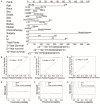A population-based study: how to identify high-risk T1 gastric cancer patients?
- PMID: 33948368
- PMCID: PMC8085846
A population-based study: how to identify high-risk T1 gastric cancer patients?
Abstract
In T1 gastric cancer (GC), lymph nodes metastasis (LNM) is considered as a significant prognostic predictor and closely associated with following therapeutic approaches as well as distant metastasis (DM). This study aimed to not only seek risk factors of LNM and DM but also unpack the prognosis in T1 GC patients. We performed a retrospective study enrolling 5547 patients in T1 GC from the Surveillance, Epidemiology, and End Results (SEER) database. Univariate and multivariate logistic regression models were produced to recognize independent risk factors of LNM and DM. Cox regression analyses were performed to identify important prognostic factors of overall survival (OS). Cancer-specific cumulative incidence was plotted by cumulative incidence function. Three nomograms of LNM, DM and OS were established and validated by receiver operating characteristic (ROC) and calibration curves to evaluate discrimination and accuracy. Decision curve analysis (DCA), clinical impact curves (CIC) and subgroups based on risk scores were constructed to measure nomograms clinical utility. The area under the curve (AUC) of LNM nomogram and DM nomogram were 0.735 and 0.896, respectively. OS nomogram was constructed and the corresponding C-index was 0.797. In conclusion, our user-friendly nomograms, which aimed to predict LNM, DM and OS in T1 gastric cancer patients, have shown high efficiency of discrimination and accuracy. These useful and visual tools may have advantageous clinical utility to identify high-risk T1 gastric patients and help clinicians to draw up an individual therapeutic strategy.
Keywords: SEER; T1 gastric cancer; distant metastasis; lymph nodes metastasis; nomogram; prognosis.
AJCR Copyright © 2021.
Conflict of interest statement
None.
Figures







Similar articles
-
Risk factors and predictors of lymph nodes metastasis and distant metastasis in newly diagnosed T1 colorectal cancer.Cancer Med. 2020 Jul;9(14):5095-5113. doi: 10.1002/cam4.3114. Epub 2020 May 29. Cancer Med. 2020. PMID: 32469151 Free PMC article.
-
Clinical models to predict lymph nodes metastasis and distant metastasis in newly diagnosed early esophageal cancer patients: A population-based study.Cancer Med. 2023 Mar;12(5):5275-5292. doi: 10.1002/cam4.5334. Epub 2022 Oct 7. Cancer Med. 2023. PMID: 36205033 Free PMC article.
-
A Population-Based Study: How to Identify High-Risk T1-2 Esophageal Cancer Patients?Front Oncol. 2021 Dec 13;11:766181. doi: 10.3389/fonc.2021.766181. eCollection 2021. Front Oncol. 2021. PMID: 34966675 Free PMC article.
-
Analysis of risk factors for lymph node metastasis and prognosis study in patients with early gastric cancer: A SEER data-based study.Front Oncol. 2023 Mar 17;13:1062142. doi: 10.3389/fonc.2023.1062142. eCollection 2023. Front Oncol. 2023. PMID: 37007147 Free PMC article.
-
Predictors of Distant Metastasis and Prognosis in Newly Diagnosed T1 Intrahepatic Cholangiocarcinoma.Biomed Res Int. 2023 Jan 17;2023:6638755. doi: 10.1155/2023/6638755. eCollection 2023. Biomed Res Int. 2023. PMID: 36704724 Free PMC article. Review.
Cited by
-
Influence of visceral adipose tissue on the accuracy of tumor T-staging of gastric cancer in preoperative CT.Jpn J Radiol. 2025 Apr;43(4):656-665. doi: 10.1007/s11604-024-01711-3. Epub 2024 Nov 28. Jpn J Radiol. 2025. PMID: 39607533
-
Construction and validation of a prognostic nomogram for anal squamous cell carcinoma.Cancer Med. 2022 Jan;11(2):392-405. doi: 10.1002/cam4.4458. Epub 2021 Dec 1. Cancer Med. 2022. PMID: 34850581 Free PMC article.
-
Establishment and validation of a prognostic nomogram for patients with renal cell carcinoma based on SEER and TCGA database.Transl Cancer Res. 2023 Jun 30;12(6):1411-1421. doi: 10.21037/tcr-22-2692. Epub 2023 Jun 9. Transl Cancer Res. 2023. PMID: 37434676 Free PMC article.
-
Construction and validation of a nomogram based on the log odds of positive lymph nodes to predict the prognosis of T1 gastric cancer.Sci Rep. 2025 Mar 5;15(1):7788. doi: 10.1038/s41598-025-91265-9. Sci Rep. 2025. PMID: 40044765 Free PMC article.
-
Application of machine learning algorithm in predicting distant metastasis of T1 gastric cancer.Sci Rep. 2023 Apr 7;13(1):5741. doi: 10.1038/s41598-023-31880-6. Sci Rep. 2023. PMID: 37029221 Free PMC article.
References
-
- Bray F, Ferlay J, Soerjomataram I, Siegel RL, Torre LA, Jemal A. Global cancer statistics 2018: GLOBOCAN estimates of incidence and mortality worldwide for 36 cancers in 185 countries. CA Cancer J Clin. 2018;68:394–424. - PubMed
-
- Siegel RL, Miller KD, Jemal A. Cancer statistics, 2020. CA Cancer J Clin. 2020;70:7–30. - PubMed
-
- Oh SY, Lee JH, Lee HJ, Kim TH, Huh YJ, Ahn HS, Suh YS, Kong SH, Kim GH, Ahn SJ, Kim SH, Choi Y, Yang HK. Natural history of gastric cancer: observational study of gastric cancer patients not treated during follow-up. Ann Surg Oncol. 2019;26:2905–2911. - PubMed
-
- Everett SM, Axon AT. Early gastric cancer: disease or pseudo-disease? Lancet. 1998;351:1350–1352. - PubMed
-
- Hanada Y, Choi AY, Hwang JH, Draganov PV, Khanna L, Sethi A, Bartel MJ, Goel N, Abe S, De Latour RA, Park K, Melis M, Newman E, Hatzaras I, Reddy SS, Farma JM, Liu X, Schlachterman A, Kresak J, Trapp G, Ansari N, Schrope B, Lee JY, Dhall D, Lo S, Jamil LH, Burch M, Gaddam S, Gong Y, Del Portillo A, Tomizawa Y, Truong CD, Brewer Gutierrez OI, Montgomery E, Johnston FM, Duncan M, Canto M, Ahuja N, Lennon AM, Ngamruengphong S. Low frequency of lymph node metastases in patients in the united states with early-stage gastric cancers that fulfill japanese endoscopic resection criteria. Clin Gastroenterol Hepatol. 2019;17:1763–1769. - PubMed
LinkOut - more resources
Full Text Sources
Miscellaneous
